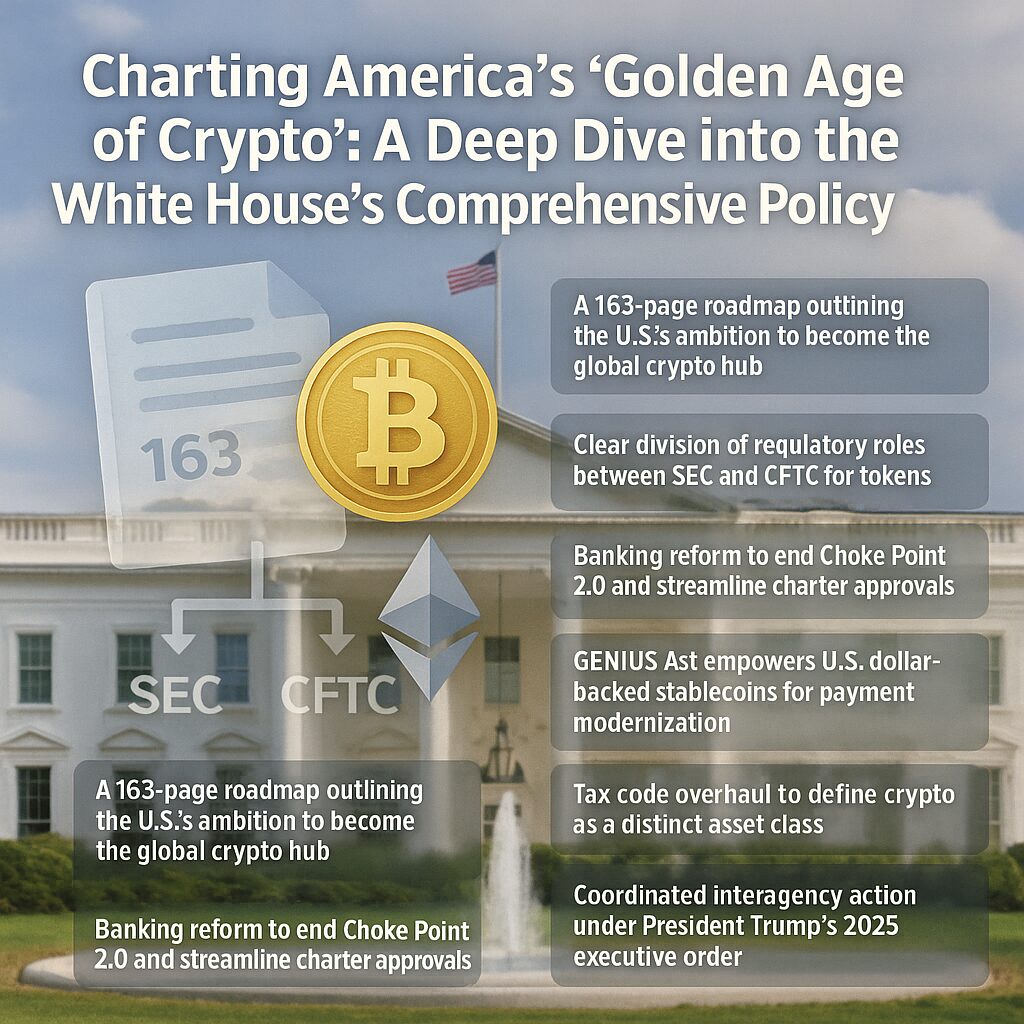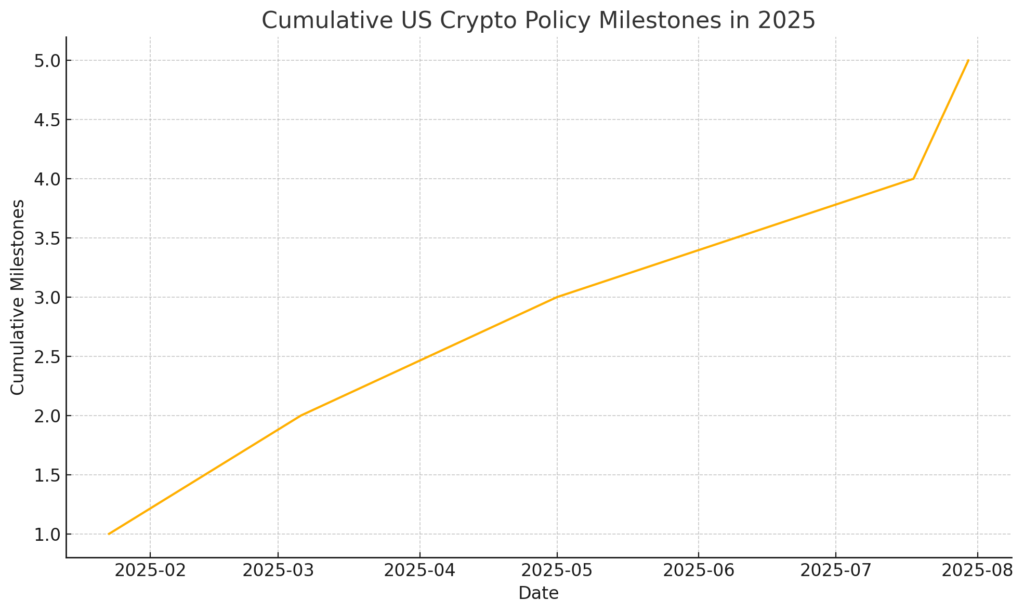
Main Points:
- A 163-page roadmap outlining the U.S.’s ambition to become the global crypto hub
- Clear division of regulatory roles between SEC and CFTC for tokens
- Banking reform to end Choke Point 2.0 and streamline charter approvals
- GENIUS Act empowers U.S. dollar–backed stablecoins for payment modernization
- Strengthened AML/CFT rules and balanced DeFi privacy protections
- Tax code overhaul to define crypto as a distinct asset class
- Coordinated interagency action under President Trump’s 2025 executive order
Introduction
On July 30, 2025, the White House released a landmark report titled “Strengthening American Leadership in Digital Financial Technology,” fulfilling President Trump’s pledge to make the United States the “crypto capital of the world.” Spanning 163 pages, the document synthesizes six months of deliberations by the President’s Working Group on Digital Asset Markets—a task force chaired by SEC Chair Paul Atkins and Treasury Secretary Scott Bessent—into a unified strategy that marries robust innovation with investor protection.
Key Recommendations and Goals
- Regulatory Clarity through Legislation
Promotes swift passage of the CLARITY Act, explicitly assigning CFTC jurisdiction over commodity-like tokens and SEC oversight of security-like tokens. Urges agencies to issue immediate guidance on custody and recordkeeping to alleviate legal uncertainty. - Banking Reform & Choke Point 2.0
Concludes the Choke Point 2.0 policy, restoring access to banking services for crypto firms. Recommends transparent chartering processes for federal bank licenses, revising capital requirements to realistic levels, and endorsing FDIC and OCC moves to green-light crypto custody functions. - Stablecoins as Payment Rails
Highlights the passage of the GENIUS Act on July 18, 2025, to establish regulatory guardrails around dollar-pegged tokens. Advocates rapid rulemaking for stablecoin issuers, positioning USD-backed tokens as the backbone of next-generation payment systems. - Enhanced AML/CFT & DeFi Oversight
Calls for clearer Bank Secrecy Act reporting standards on crypto flows, balanced with privacy protections for self-custody users and DeFi participants. Emphasizes that legitimate personal transactions should not be over-regulated, maintaining a pro-innovation stance. - Crypto Tax Overhaul
Proposes defining crypto as a standalone asset class under federal tax code, revising wash-sale rules, and clarifying tax treatment for staking and mining rewards. Urges IRS to issue timely guidance on token wrapping and small-value transfers to simplify compliance.
Timeline of Major Policy Milestones
[Insert Figure 1: Cumulative US Crypto Policy Milestones in 2025 here]

- Jan 23 – Executive Order 14178 establishes the Working Group on Digital Asset Markets.
- Mar 6 – Executive Order to create Strategic Bitcoin Reserve and U.S. Digital Asset Stockpile.
- May 1 – CFTC issues first guidance on non-security token custody.
- Jul 18 – President signs the GENIUS Act, U.S.’s first stablecoin regulation.
- Jul 30 – Release of the 163-page comprehensive policy report.
In-Depth Analysis of Key Sections
1. Regulatory Division: SEC vs. CFTC
The report underscores that “commodity-type” tokens (e.g., BTC, ETH) fall under CFTC purview, while “security-type” tokens (e.g., certain ICO-issued coins) remain with the SEC. This delineation aims to prevent jurisdictional overlap and streamline enforcement, bolstering confidence among issuers and market makers.
2. Banking Charter Modernization
By recommending clear, risk-based capital rules and transparent charter application timelines, the administration seeks to eradicate the de-banking of crypto businesses witnessed under prior policies. Encouraging FDIC and OCC to finalize guidelines on custody, this move is expected to accelerate product launches, reduce counterparty risk, and foster deeper institutional participation.
3. Stablecoins and Payment Innovation
With the GENIUS Act codifying reserve requirements and issuer audits, U.S. dollar stablecoins are primed to supplant legacy rails. Treasury and bank regulators are asked to facilitate pilot programs integrating stablecoins into merchant networks and cross-border corridors, potentially slashing remittance costs by up to 70% in key corridors.
4. Anti-Money Laundering & Privacy
Strengthening reporting obligations under the Bank Secrecy Act, the report also insists on measured enforcement in DeFi, ensuring that valid self-custody and peer-to-peer transactions remain accessible. This balanced approach addresses FATF travel-rule requirements while preserving the foundational ethos of blockchain privacy.
5. Taxation Framework
The proposal to treat crypto as its own asset class aims to resolve ambiguities around wash-sale rules and taxable events for staking. By asking the IRS to issue regulations by Q1 2026 on token wrapping and micro-transaction de-minimis thresholds, everyday users and institutional investors alike will gain certainty in reporting obligations.
Conclusion
The White House’s comprehensive report lays out an ambitious, interagency roadmap to cement U.S. leadership in digital finance. With clear regulatory boundaries, banking charters restored, stablecoins embraced as next-wave payment rails, and a modern tax and AML framework, the administration envisions a “Golden Age of Crypto.” Successful enactment of the CLARITY Act, swift rulemaking under the GENIUS Act, and the upcoming details on the Strategic Bitcoin Reserve will determine whether America truly becomes the global hub for blockchain innovation and digital assets.

